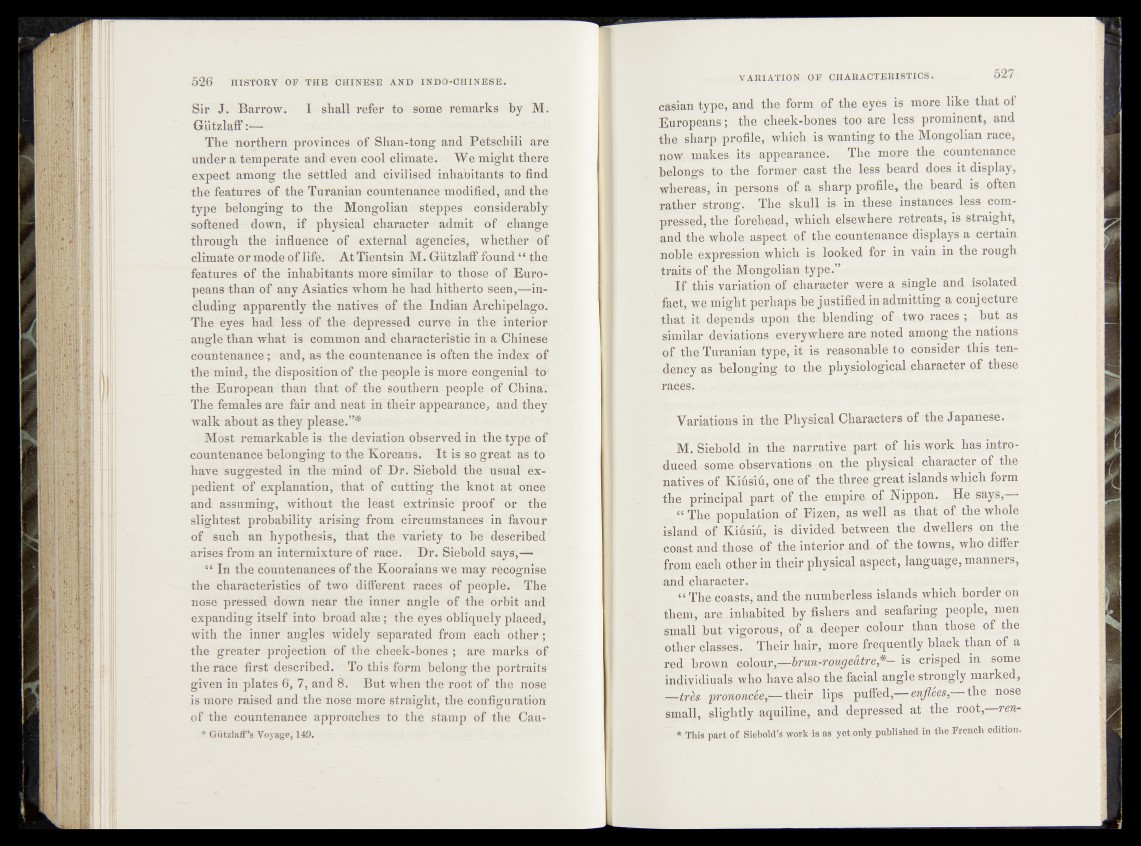
Sir J. Barrow. I shall refer to some remarks by M.
Giitzlaff:—
The northern provinces of Shan-tong and Petschili are
under a temperate and even cool climates We might there
expect among the settled and civilised? inhabitants to find
the features of the Turanian countenance modified, and the
type belonging to the Mongolian steppes; considerably
softened—down, if physical character admit of change
through the influence of external agencies, whether of
climate or mode of life. At Tientsin M* Giitzlaff found “ the
features of the inhabitants more similar to those? of Europeans
than of any Asiatics whom he had hitherto seen,—including
apparently the natives of the Indian Archipelago.
The eyes had less of the depressed curve in -the interior
anglelhan what is common and characteristic in a Chinese
countenance; and, as the countenance is often the index of
the mind, the disposition of the people is more congenial td'
the European than that of the southern people of China.
The females are fair and neat in their appearance, and they
walk about as they please.”*
Most remarkable is the deviation observed in the type'of
countenance belonging to the Koreans1. It is :so great as to
have suggested in the mind of Dr. Siebold the usual ex-
pedient of explanation, that of cutting the-knot at once
and assuming, without the least extrinsic*1 proof or the
slightest probability arising from circumstances in favour
of such an hypothesis, that the variety to^be'1 described
arises from an intermixture of race. ' Dr. Siebold says,'—
“ In the countenances of the Kooraians we may recognise
the characteristics of two different races of people.' The
nose pressed down near the inner angle of the orbit and
expanding itself into broad alee ; the eyes obliquely placed,
with the inner angles widely separated from each other;
the greater projection of the cheek-bones ; are marks of
the race first described. To this form belong the portraits
given in plates 6, 7, and 8. But when the root of the nose
is more raised and the nose more straight, the configuration
of the countenance approaches to the stamp of the Cau-
* Giitzlaff’s Voyage, 149.
casian type, and the form of the eyes is more like that of
Europeans ; the cheek-bones too are less prominent, and
the sharp profile.,- which is wanting to the Mongolian race,
now makes its appearances The more the countenance
belongs to the former cast the less beard does it display,
whereas, in persons. of a sharp profile, the beard is often
rather strong-.^ The skid! ; is in these instances less compressed,
the forehead, which elsewhere retreats, is straight,
and the whole aspect of the, countenance displays a certain
noble expression which is- looked for in vain in the rough
traits of the Mongolian type.’«*
If this variation of- .character were a single and isolated
fact, we might perhaps be justified in admitting a conjecture
that it-depends upon, the blending of two races ; but as
similar deviations everywhere are noted among the nations
of the Turanian type, it is reasonable to consider this tendency
as belonging to the physiological character of these
races.
; Variations in the Physical Characters of the Japanese.
M. Sip^old in t\e narrative part .of his work has intro-
duced.jjfipe observations, on the physical, character of the
natives of Kiusih, one of the three .gr,eat islands which form
the principal part of, the-empira of Nip pop.. He says,—-
* “ The population of Fizen, as well ,as that of the whole
island of Kiûsiiî, is divided between the. dwellers on the
coast and those- of the interior and of, tjie towns, who differ
from each other in their physical aspect, language, manners,
and eharee|^.,g,i>. gjg&k îÉîjlï jfc
“ The coasts, and the nuinjj^rless islands which border on
them, are,.inhabited by fishers and .seafaring people, men
small but vigorçuf, of a deeper, colour than those of the
other classes. Their hair, more frequently black than of a
red brown qolour,—brun-rougeâtre*— is ^c|i^ped:iin some
individiuaîs; who }ha,ve also the facial angle strongly marked,
—-très prononcée^—their lips puffed,— the nose
small, slightly aquiline, and depressed at the root,—ren-
P * This part of Siebold’s work is as yet only published in .the French edition.